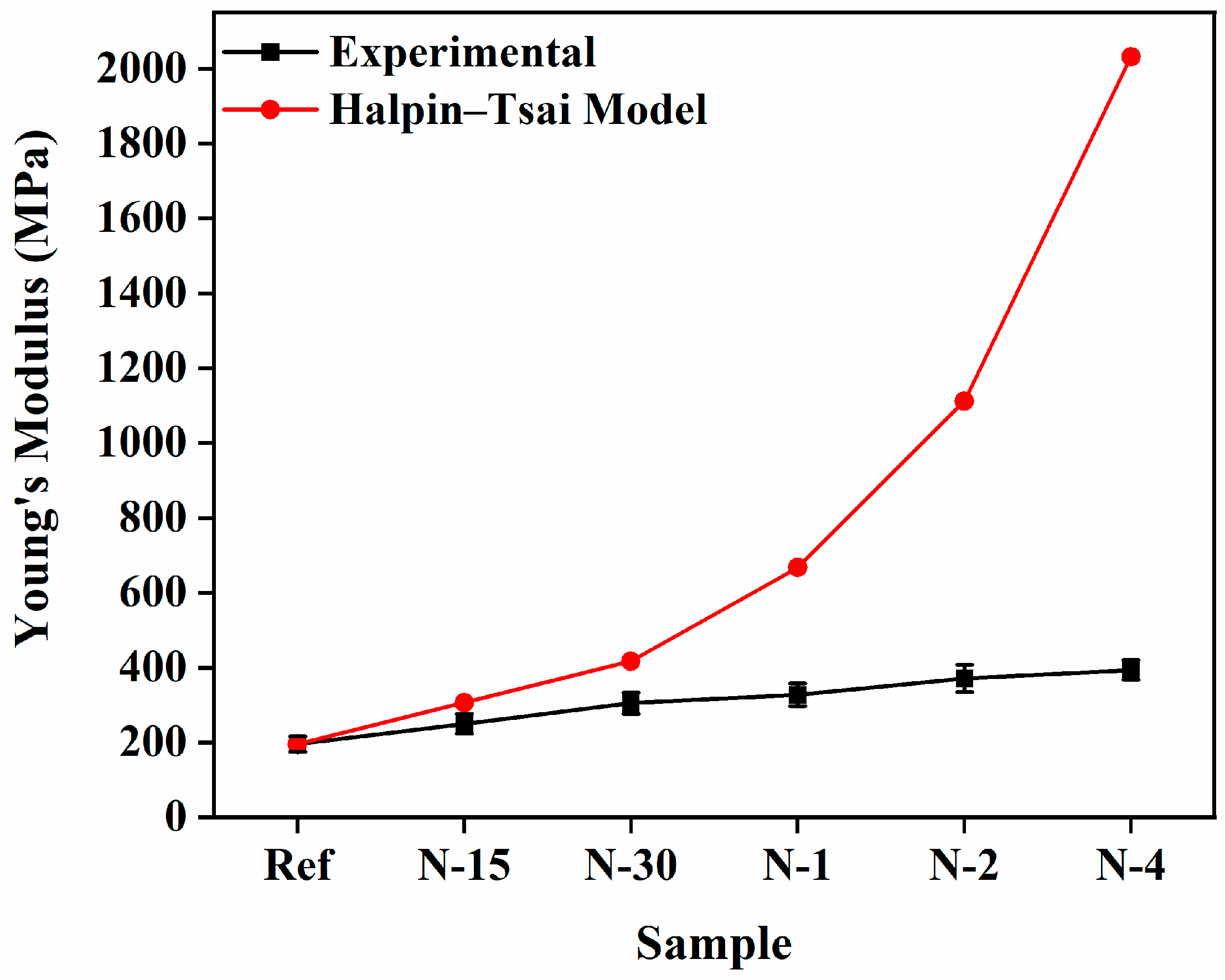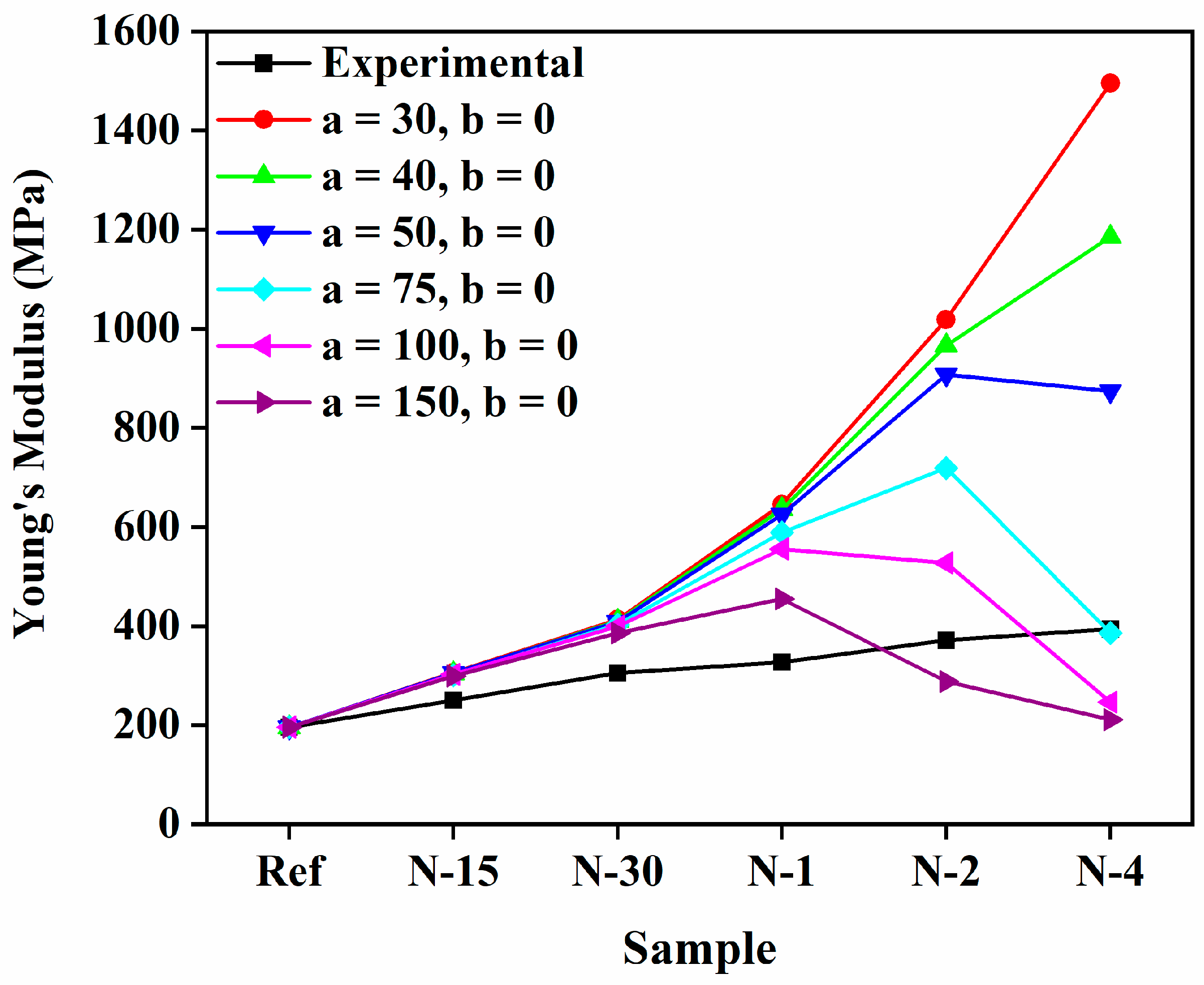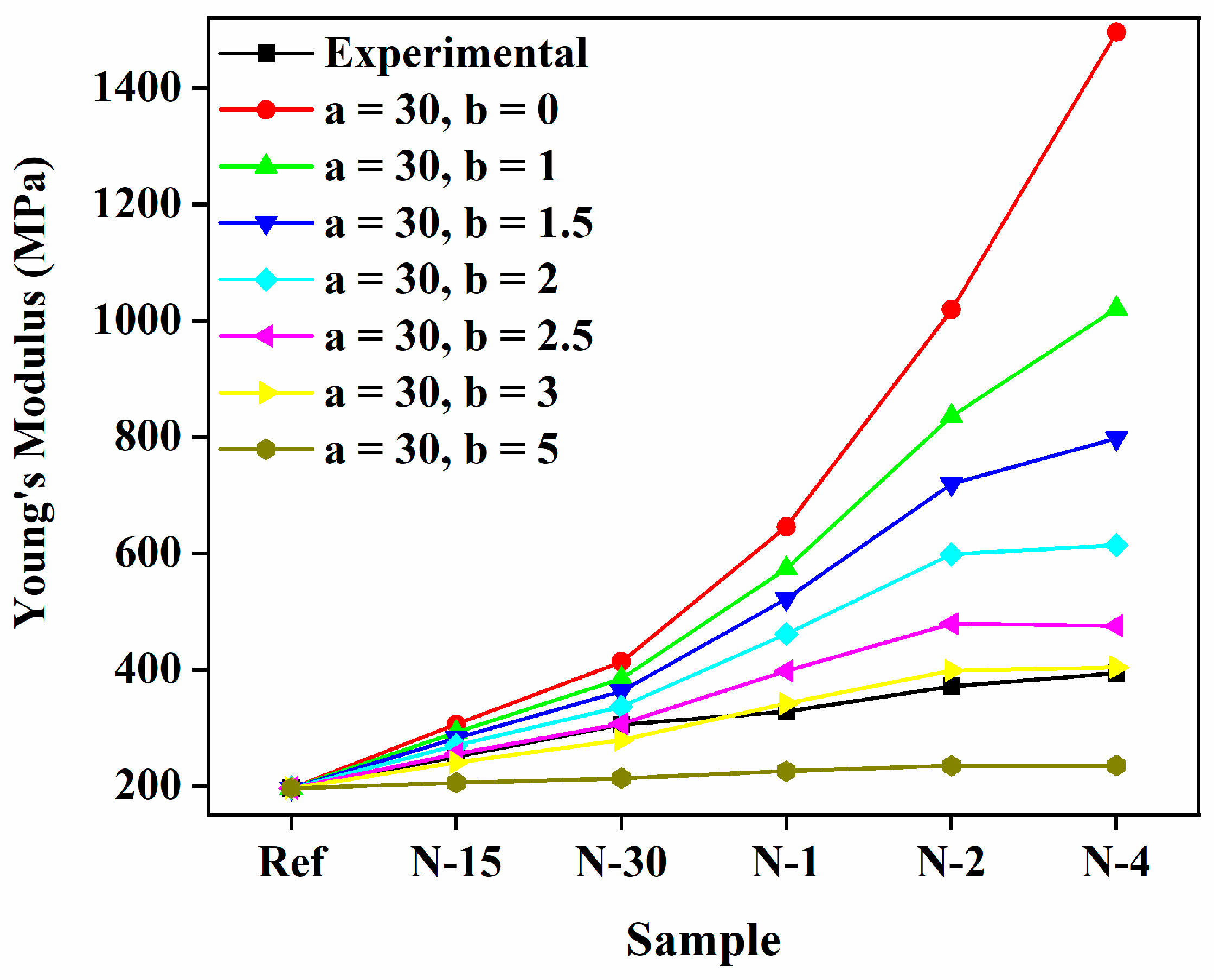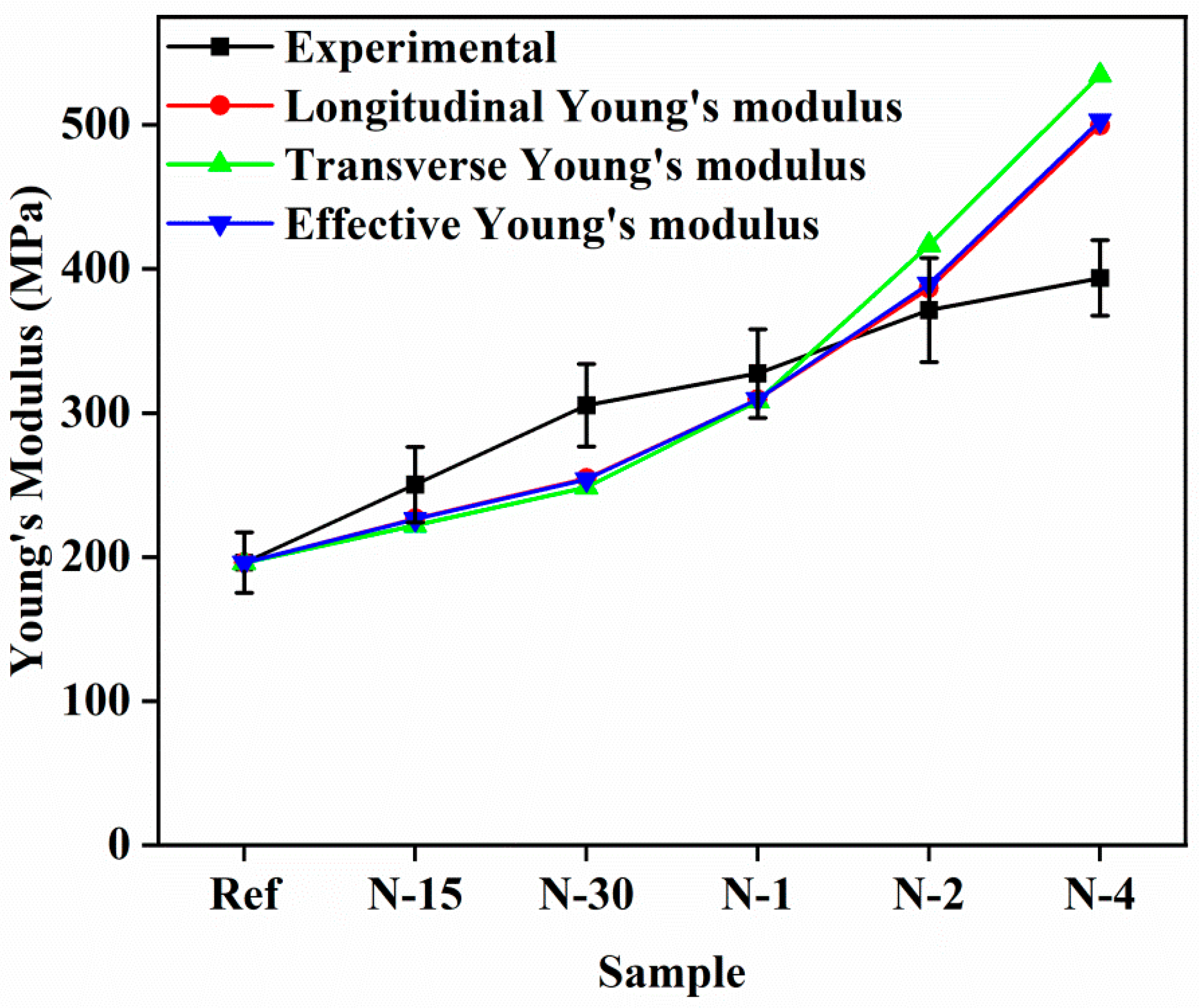Considering Electrospun Nanofibers as a Filler Network in Electrospun Nanofiber-Reinforced Composites to Predict the Tensile Strength and Young’s Modulus of Nanocomposites: A Modeling Study
Abstract
:1. Introduction
2. Experimental
2.1. Materials
2.2. Method
3. Theoretical Models
3.1. Models for Tensile Strength
3.2. Models for Young’s Modulus
4. Results and Discussion
4.1. Tensile Strength of the Nanofiber-Reinforced Composites
4.2. Young’s Modulus of the Nanofiber-Reinforced Composites
5. Conclusions
Author Contributions
Funding
Institutional Review Board Statement
Informed Consent Statement
Data Availability Statement
Conflicts of Interest
References
- Kim, D.J.; Jo, M.J.; Nam, S.Y. A review of polymer-nanocomposite electrolyte membranes for fuel cell application. J. Ind. Eng. Chem. 2015, 21, 36–52. [Google Scholar] [CrossRef]
- Hussain, F.; Hojjati, M.; Okamoto, M.; Gorga, R.E. Review article: Polymer-matrix Nanocomposites, Processing, Manufacturing, and Application: An Overview. J. Compos. Mater. 2006, 40, 1511–1575. [Google Scholar] [CrossRef]
- Abdullahi Hassan, Y.; Hu, H. Current status of polymer nanocomposite dielectrics for high-temperature applications. Compos. Part A Appl. Sci. Manuf. 2020, 138, 106064. [Google Scholar] [CrossRef]
- Hu, H.; Zhang, F.; Luo, S.; Chang, W.; Yue, J.; Wang, C.-H. Recent advances in rational design of polymer nanocomposite dielectrics for energy storage. Nano Energy 2020, 74, 104844. [Google Scholar] [CrossRef]
- Miculescu, M.; Thakur, V.K.; Miculescu, F.; Voicu, S.I. Graphene-based polymer nanocomposite membranes: A review. Polym. Adv. Technol. 2016, 27, 844–859. [Google Scholar] [CrossRef]
- Valavala, P.K.; Odegard, G.M. Modeling techniques for determination of mechanical properties of polymer nanocomposites. Rev. Adv. Mater. Sci. 2005, 9, 34–44. [Google Scholar]
- Maghsoudlou, M.A.; Barbaz Isfahani, R.; Saber-Samandari, S.; Sadighi, M. Effect of interphase, curvature and agglomeration of SWCNTs on mechanical properties of polymer-based nanocomposites: Experimental and numerical investigations. Compos. Part B Eng. 2019, 175, 107119. [Google Scholar] [CrossRef]
- Rahmat, M.; Hubert, P. Carbon nanotube-polymer interactions in nanocomposites: A review. Compos. Sci. Technol. 2011, 72, 72–84. [Google Scholar] [CrossRef]
- Lee, J.K.Y.; Chen, N.; Peng, S.; Li, L.; Tian, L.; Thakor, N.; Ramakrishna, S. Polymer-based composites by electrospinning: Preparation & functionalization with nanocarbons. Prog. Polym. Sci. 2018, 86, 40–84. [Google Scholar]
- Daglar, O.; Altinkok, C.; Acik, G.; Durmaz, H. Electrospinning of Poly(1,4-Cyclohexanedimethylene Acetylene Dicarboxylate): Study on the Morphology, Wettability, Thermal and Biodegradation Behaviors. Macromol. Chem. Phys. 2020, 221, 2000310. [Google Scholar] [CrossRef]
- Gavande, V.; Im, D.; Jin, Y.; Lim, K.T.; Lee, W.K. 3D bio polybutylene succinate electrospun nanofiber scaffolds for biomimetic structure. Mol. Cryst. Liq. Cryst. 2020, 706, 55–61. [Google Scholar] [CrossRef]
- Kumbar, S.G.; James, R.; Nukavarapu, S.P.; Laurencin, C.T. Electrospun nanofiber scaffolds: Engineering soft tissues. Biomed. Mater. 2008, 3, 034002. [Google Scholar] [CrossRef] [PubMed]
- Ghosal, K.; Agatemor, C.; Špitálsky, Z.; Thomas, S.; Kny, E. Electrospinning tissue engineering and wound dressing scaffolds from polymer-titanium dioxide nanocomposites. Chem. Eng. J. 2019, 358, 1262–1278. [Google Scholar] [CrossRef]
- Gavande, V.; Lee, S.; Im, D.; Nagappan, S.; Ha, C.S.; Lee, W.K. Polyketone nanofiber: An effective reinforcement for the development of novel UV-curable, highly transparent and flexible polyurethane nanocomposite films. Polym. Int. 2020, 69, 1008–1017. [Google Scholar] [CrossRef]
- Jiang, S.; Chen, Y.; Duan, G.; Mei, C.; Greiner, A.; Agarwal, S. Electrospun nanofiber reinforced composites: A review. Polym. Chem. 2018, 9, 2685–2720. [Google Scholar] [CrossRef]
- Gavande, V.; Im, D.; Lee, W.K. Development of highly transparent UV-curable nylon 6 nanofiber-reinforced polyurethane acrylate nanocomposite coatings for pre-coated metals. J. Appl. Polym. Sci. 2021, 138, 50614. [Google Scholar] [CrossRef]
- Anstey, A.; Chang, E.; Kim, E.S.; Rizvi, A.; Kakroodi, A.R.; Park, C.B.; Lee, P.C. Nanofibrillated polymer systems: Design, application, and current state of the art. Prog. Polym. Sci. 2021, 113, 101346. [Google Scholar] [CrossRef]
- Huang, C.; Xu, X.; Fu, J.; Yu, D.G.; Liu, Y. Recent Progress in Electrospun Polyacrylonitrile Nanofiber-Based Wound Dressing. Polymers 2022, 14, 3266. [Google Scholar] [CrossRef]
- Chew, S.Y.; Hufnagel, T.C.; Lim, C.T.; Leong, K.W. Mechanical properties of single electrospun drug-encapsulated nanofibres. Nanotechnology 2006, 17, 3880–3891. [Google Scholar] [CrossRef]
- Papkov, D.; Zou, Y.; Andalib, M.N.; Goponenko, A.; Cheng, S.Z.D.; Dzenis, Y.A. Simultaneously strong and tough ultrafine continuous nanofibers. ACS Nano 2013, 7, 3324–3331. [Google Scholar] [CrossRef]
- Mosallanezhad, P.; Nazockdast, H.; Ahmadi, Z.; Rostami, A. Fabrication and characterization of polycaprolactone/chitosan nanofibers containing antibacterial agents of curcumin and ZnO nanoparticles for use as wound dressing. Front. Bioeng. Biotechnol. 2022, 10, 1–14. [Google Scholar] [CrossRef] [PubMed]
- Altinkok, C.; Acik, G.; Daglar, O.; Durmaz, H.; Tunc, I.; Agel, E. A facile approach for the fabrication of antibacterial nanocomposites: A case study for AgNWs/Poly(1,4-Cyclohexanedimethylene Acetylene Dicarboxylate) composite networks by aza-Michael addition. Eur. Polym. J. 2022, 169, 111130. [Google Scholar] [CrossRef]
- Wang, G.; Yu, D.; Kelkar, A.D.; Zhang, L. Electrospun nanofiber: Emerging reinforcing filler in polymer matrix composite materials. Prog. Polym. Sci. 2017, 75, 73–107. [Google Scholar] [CrossRef]
- Gavande, V.; Im, D.; Jin, Y.; Lee, W.-K. Fabrication of toughest and transparent electrospun nylon 6 nanofiber-reinforced PVA composites. Mol. Cryst. Liq. Cryst. 2021, 729, 48–54. [Google Scholar] [CrossRef]
- Sun, L.; Han, R.P.S.; Wang, J.; Lim, C.T. Modeling the size-dependent elastic properties of polymeric nanofibers. Nanotechnology 2008, 19, 455706. [Google Scholar] [CrossRef]
- Cox, H.L. The elasticity and strength of paper and other fibrous materials. Br. J. Appl. Phys. 1952, 3, 72–79. [Google Scholar] [CrossRef]
- Nicolais, L.; Narkis, M. Stress-strain behavior of styrene-acrylonitrile/glass bead composites in the glassy region. Polym. Eng. Sci. 1971, 11, 194–199. [Google Scholar] [CrossRef]
- Pukánszky, B. Influence of interface interaction on the ultimate tensile properties of polymer composites. Composites 1990, 21, 255–262. [Google Scholar] [CrossRef]
- Abraham, R.; Selvin Thomas, P.; Kuryan, S.; Issac, J.; Nandakumar, K.; Thomas, S. Structural and mechanical properties of YBCO-polystyrene composites. J. Appl. Polym. Sci. 2010, 118, 1027–1041. [Google Scholar] [CrossRef]
- Kundalwal, S.I. Review on Modeling of Mechanical and Thermal Properties of Nano- and Micro-Composites. arXiv 2017, arXiv:1708.00764. [Google Scholar]
- Salam, H.; Dong, Y. Theoretical modelling analysis on tensile properties of bioepoxy/clay nanocomposites using epoxidised soybean oils. J. Nanomater. 2019, 2019, 4074869. [Google Scholar] [CrossRef] [Green Version]
- Halpin, J.C. Stiffness and Expansion Estimates for Oriented Short Fiber Composites. J. Compos. Mater. 1969, 3, 732–734. [Google Scholar] [CrossRef]
- Patterson, W.; Force, A. The Halpin-Tsai Equations: A Review. Polym. Eng. Sci. 1976, 16, 344–352. [Google Scholar]
- Marathe, U.; Padhan, M.; Bijwe, J. Carbon nanotubes—A powerful nano-filler for enhancing the performance properties of polyetherketoneketone composites and adhesives. Compos. Sci. Technol. 2021, 210, 108813. [Google Scholar]
- Marathe, U.; Padhan, M.; Bijwe, J. Various attributes controlling the performance of nano-composites and adhesives of TiC-PAEK. Compos. Sci. Technol. 2021, 214, 108969. [Google Scholar] [CrossRef]
- Ounaies, Z.; Sun, L.H.; Gao, X.L.; Whalen, C.A.; Yang, Z.G. Preparation, characterization, and modeling of carbon nanofiber/epoxy nanocomposites. J. Nanomater. 2011, 2011, 307589. [Google Scholar]
- Luo, Z.; Li, X.; Shang, J.; Zhu, H.; Fang, D. Modified rule of mixtures and Halpin–Tsai model for prediction of tensile strength of micron-sized reinforced composites and Young’s modulus of multiscale reinforced composites for direct extrusion fabrication. Adv. Mech. Eng. 2018, 10, 1–10. [Google Scholar] [CrossRef]
- Yeh, M.K.; Tai, N.H.; Liu, J.H. Mechanical behavior of phenolic-based composites reinforced with multi-walled carbon nanotubes. Carbon N. Y. 2006, 44, 1–9. [Google Scholar] [CrossRef]
- Kurita, H.; Ishigami, R.; Wu, C.; Narita, F. Mechanical properties of mechanically-defibrated cellulose nanofiber reinforced epoxy resin matrix composites. J. Compos. Mater. 2021, 55, 455–464. [Google Scholar] [CrossRef]
- Hu, H.; Onyebueke, L.; Abatan, A. Characterizing and Modeling Mechanical Properties of Nanocomposites-Review and Evaluation. J. Miner. Mater. Charact. Eng. 2010, 9, 275–319. [Google Scholar]
- Venkateshwaran, N.; Elayaperumal, A. Modeling and evaluation of tensile properties of randomly oriented banana/epoxy composite. J. Reinf. Plast. Compos. 2011, 30, 1957–1967. [Google Scholar] [CrossRef]







| Samples | Theoretical Density | Practical Density | wt% of Nanofibers | Volume Fraction of the Nanofibers | Volume Fraction of the PUA Matrix |
|---|---|---|---|---|---|
| PUA | 1.19 | 1.1968 | 0 | 0 | 100 |
| N-15 | 1.2 | 1.1964 | 0.0038 | 0.004 | 99.96 |
| N-30 | 1.2 | 1.1957 | 0.0075 | 0.008 | 99.92 |
| N-60 | 1.19 | 1.1944 | 0.015 | 0.017 | 99.83 |
| N-2 h | 1.19 | 1.1928 | 0.03 | 0.033 | 99.67 |
| N-4 h | 1.19 | 1.1918 | 0.06 | 0.066 | 99.34 |
| Sample | Tensile Strength at Break (MPa) | % Elongation at Break | Tensile Strength at Yield (MPa) | Young’s Modulus (MPa) | |
|---|---|---|---|---|---|
| PUA films | 15.20 ± 2.36 | 75.45 ± 7.74 | 5.78 ± 0.93 | 196.09 ± 20.99 | |
| N6/PUA nanocomposite films | N-15 | 17.42 ± 1.01 | 90.66 ± 3.12 | 6.71 ± 0.44 | 250.25 ± 26.33 |
| N-30 | 18.46 ± 0.82 | 86.22 ± 2.68 | 6.88 ± 1.07 | 305.34 ± 28.73 | |
| N-60 | 20.88 ± 0.46 | 84.77 ± 5.31 | 7.45 ± 0.95 | 327.47 ± 30.82 | |
| N-2 h | 22.89 ± 0.50 | 89.44 ± 6 | 10 ± 2.31 | 371. 35 ± 36.11 | |
| N-4 h | 28.14 ± 2.36 | 86.55 ± 2.29 | 9.93 ± 1.28 | 393.72 ± 26.20 | |
Publisher’s Note: MDPI stays neutral with regard to jurisdictional claims in published maps and institutional affiliations. |
© 2022 by the authors. Licensee MDPI, Basel, Switzerland. This article is an open access article distributed under the terms and conditions of the Creative Commons Attribution (CC BY) license (https://creativecommons.org/licenses/by/4.0/).
Share and Cite
Gavande, V.; Nagappan, S.; Lee, W.-K. Considering Electrospun Nanofibers as a Filler Network in Electrospun Nanofiber-Reinforced Composites to Predict the Tensile Strength and Young’s Modulus of Nanocomposites: A Modeling Study. Polymers 2022, 14, 5425. https://doi.org/10.3390/polym14245425
Gavande V, Nagappan S, Lee W-K. Considering Electrospun Nanofibers as a Filler Network in Electrospun Nanofiber-Reinforced Composites to Predict the Tensile Strength and Young’s Modulus of Nanocomposites: A Modeling Study. Polymers. 2022; 14(24):5425. https://doi.org/10.3390/polym14245425
Chicago/Turabian StyleGavande, Vishal, Saravanan Nagappan, and Won-Ki Lee. 2022. "Considering Electrospun Nanofibers as a Filler Network in Electrospun Nanofiber-Reinforced Composites to Predict the Tensile Strength and Young’s Modulus of Nanocomposites: A Modeling Study" Polymers 14, no. 24: 5425. https://doi.org/10.3390/polym14245425










